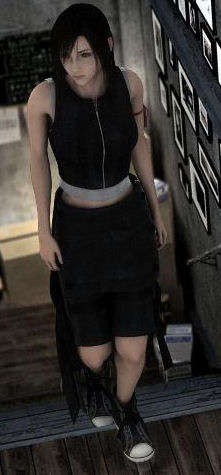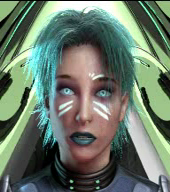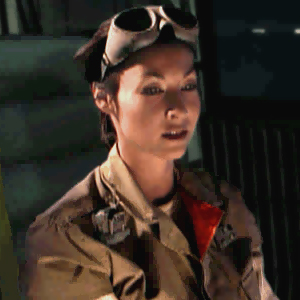SDN Women of Video Games Competition (p1)
Posted: 2009-10-27 07:02pm
This thread is inspired by the "all game avatars are the same"or more specifically the link within it named "top then female characters that don't use sex to sell". Namely, many people disagreed with it, including myself.
A point of interest is the objectification and/or over-sexualization of women. Women that serve little other purpose than eye-candy, with ridiculously revealing outfits (often made even more ludicrous under the circumstances in which they live), having perfect proportions, hair and skin at all times, displaying themselves seductively with flimsy justification for doing so, but most of all, not wearing a proper fucking bra and not screaming about back pain.
However, this is not always the case: some developers have recognised this and moved beyond. Developers that have made women in video games that have lovable personalities, identifiable emotional scenes, memorable moments, admirable intellect and/or courage, valuable company during game-play or at least not have breasts the size that chime with "back pain".
So, rather than constantly whine about the same old same-old, why not celebrate these characters by a community-based voting?
I plan to to have two stages for this:
First, is naming all the characters that deserve to be put on the list, according to (openly arguable and contestable) criteria I lined out below.
Second phase (and thread) is voting: taking a finalised list and voting for characters you believe are good examples. If the board's software is unable to automate the process (I have yet to test it to its full potential) I will gather votes. The details of this will be given when the thread is made.
A third thread may be created to give the finalised ranking results and discuss them.
Now, unto the criteria on which competitors may be selected. Remember, these are not rules, but guidelines and you may feel free to challenge or rectify them.
- The character must be a visibly identifiable as a human woman (duh!) with her own personality and voice.
The whole point of the competition. The character must be obviously a woman or given identity of a woman from early-on in the game.
For this reason, Shodan does not count, because while she may be feminine, she's an AI that is female for completely arbitrary reasons. She never acts like a human woman.
Chel should also be on grounds for disqualification because we learned absolutely nothing about her during her game, Portal.
That said, the character should not necessarily be human, merely identifiable as such. She may be a robot or alien or elf, it only matters that she mostly looks like a human and acts like one.
- The character must featured either as the player avatar or as a major character in at least one video game (duh again).
The character must be shown in a video game either as someone the player controls or as someone the player regularly has contact and some kind of relationship with. Characters that only appear in the distance or only occasionally should not count, as it would draw a lot in a little picture
-The character should not have an over-sexualized appearance, including clothes that clearly are there only as fan-service or to pander to immature demographics.
This is a line that is a bit hard to draw. To try and to draw one, here is an example: a woman may ,in a video game, have large breast and still be ranked, as that alone should not disqualify. However, when the same woman has a cleavage that you can dual-purpose for smuggling operations and wears tight shirt to emphasize this even in an environment that such clothing would be impractical, does (high heels do count here). Lack of supporting bra that results in "jiggle physics" is definitely damning.
Fetish gear or similar can be a bit difficult case-by-case, because it may border the rule but not cross it. If it is in-line with the character's personality and background as well as the setting's theme or stylistic elements, it may get a pass.
- Only behaviour and appearance in canon games should count.
This includes cameos, guest appearances (a rare event in video games) or even novelization (as the character is different from the novel-writer's standpoint than from the game designer's standpoint). For example, Samus Aran should be considered from the perspective of the Metroid Series and her appearance in Super Smash Brothers Brawl should not count.
- Only the quality of character, not the game, shall be judged.
Because if we start, we'll never fucking stop, especially once the more obscure games start ranking up.
-Behaviour that are required or added for reasons of game design should also be accounted for.
How a character behaves in cut-scenes and in-game can be different, as game design has priority over story-telling and characterization.
For example, one may make the conclusion that Alxy from Half-Life ep 1 and 2 can be subservient and overly trusting to men in leadership positions based on the fact that she always lets the player (who is supposed to be a man) go with his own pace, never questioning the rate of progress or the reasons for the player's actions, as well as almost always allowing the player to take the initiative.
If you listen to the development commentary, this falls apart. You'll learn that originally Alex did comment on the player's pace more but designers found that play-testers were immensely annoyed by this and disliked Alxy because of this. Since it was important for players to like Alxy (after all, you'll be spending most of the episode with her) and her nagging interrupted the enjoyment of the game, this was cut. In fact, according to the commentary, Alxy was supposed to lead the player most of the episodes (in ep1, in the Citadel, she was supposed to lead the way after using a console to get a map) but designers cut this. So this behaviour isn't due to a reflection of Alxy's personality, just a game design decision.
- Out-of-game behaviour should be judged differently than in-game behaviour.
The rule of thumb about the position of character should be the game developer's vision. How marketing men and how the designers treat the character should be accounted for.
That is all I can think of as criteria.
I'll start about competitors.
Cate Archer from "The operative: No one lives forever".

If there is one character that should be titled "feminist hero", it is Cate Archer.
While gamers often like to mention how they were surprised about how Samus when it turned out to be that she was a woman in the original Metroid on the NES.
Cate made it quite obvious that she was a woman and did not hide the fact, using make-up and dressing fashionably (for the 60's). Yet she is just as competent and deadly as her peers expect her to be. In fact, she does not only have to be strong-willed against her enemies but also against her bosses (well, bosses' assistant) and peers as she enters a field that previously was left to men. She has to keep this when her first handful of missions turn clusterfuck upside down due to circumstances beyond her control. All while being a fairly likeable and compassionate young woman (and the feminist message is done good, that is, not shoved up our ass a repeatedly when we didn't ask for it).
Jade of "Beyond Good and Evil" (which actually wanted to be "between good and evil", hence having no connection to the philosophical work of the same name).

Jade is an interesting and very active character. While not only a reporter of a self-published magazine, as well as a photographer-for-hire, she is a martial artist and a racer, all while taking care of forgotten orphans of the war she lives in.
Alyx Vance of Half Life series, from Half-life 2 and onwards. The picture could have been better but there is only so much dirty fandom pictures I am willing to take up with.

Because sooner or later, she'll come up and we might as well get over with it.
Alyx in many sense is actually quite a dream girl: charming and smart, but also strong and tough. Valve could have easily taken her with the typical sexed-up, machismo action girls that many other video games taken up. However, guided by one of their better wisdom and policies, they decided to make an effort to establish a relatively realistic human being instead. The result is someone that is indeed extraordinary in skills and modest in appearance, but is still believable and likeable precisely because she is human.
A point of interest is the objectification and/or over-sexualization of women. Women that serve little other purpose than eye-candy, with ridiculously revealing outfits (often made even more ludicrous under the circumstances in which they live), having perfect proportions, hair and skin at all times, displaying themselves seductively with flimsy justification for doing so, but most of all, not wearing a proper fucking bra and not screaming about back pain.
However, this is not always the case: some developers have recognised this and moved beyond. Developers that have made women in video games that have lovable personalities, identifiable emotional scenes, memorable moments, admirable intellect and/or courage, valuable company during game-play or at least not have breasts the size that chime with "back pain".
So, rather than constantly whine about the same old same-old, why not celebrate these characters by a community-based voting?
I plan to to have two stages for this:
First, is naming all the characters that deserve to be put on the list, according to (openly arguable and contestable) criteria I lined out below.
Second phase (and thread) is voting: taking a finalised list and voting for characters you believe are good examples. If the board's software is unable to automate the process (I have yet to test it to its full potential) I will gather votes. The details of this will be given when the thread is made.
A third thread may be created to give the finalised ranking results and discuss them.
Now, unto the criteria on which competitors may be selected. Remember, these are not rules, but guidelines and you may feel free to challenge or rectify them.
- The character must be a visibly identifiable as a human woman (duh!) with her own personality and voice.
The whole point of the competition. The character must be obviously a woman or given identity of a woman from early-on in the game.
For this reason, Shodan does not count, because while she may be feminine, she's an AI that is female for completely arbitrary reasons. She never acts like a human woman.
Chel should also be on grounds for disqualification because we learned absolutely nothing about her during her game, Portal.
That said, the character should not necessarily be human, merely identifiable as such. She may be a robot or alien or elf, it only matters that she mostly looks like a human and acts like one.
- The character must featured either as the player avatar or as a major character in at least one video game (duh again).
The character must be shown in a video game either as someone the player controls or as someone the player regularly has contact and some kind of relationship with. Characters that only appear in the distance or only occasionally should not count, as it would draw a lot in a little picture
-The character should not have an over-sexualized appearance, including clothes that clearly are there only as fan-service or to pander to immature demographics.
This is a line that is a bit hard to draw. To try and to draw one, here is an example: a woman may ,in a video game, have large breast and still be ranked, as that alone should not disqualify. However, when the same woman has a cleavage that you can dual-purpose for smuggling operations and wears tight shirt to emphasize this even in an environment that such clothing would be impractical, does (high heels do count here). Lack of supporting bra that results in "jiggle physics" is definitely damning.
Fetish gear or similar can be a bit difficult case-by-case, because it may border the rule but not cross it. If it is in-line with the character's personality and background as well as the setting's theme or stylistic elements, it may get a pass.
- Only behaviour and appearance in canon games should count.
This includes cameos, guest appearances (a rare event in video games) or even novelization (as the character is different from the novel-writer's standpoint than from the game designer's standpoint). For example, Samus Aran should be considered from the perspective of the Metroid Series and her appearance in Super Smash Brothers Brawl should not count.
- Only the quality of character, not the game, shall be judged.
Because if we start, we'll never fucking stop, especially once the more obscure games start ranking up.
-Behaviour that are required or added for reasons of game design should also be accounted for.
How a character behaves in cut-scenes and in-game can be different, as game design has priority over story-telling and characterization.
For example, one may make the conclusion that Alxy from Half-Life ep 1 and 2 can be subservient and overly trusting to men in leadership positions based on the fact that she always lets the player (who is supposed to be a man) go with his own pace, never questioning the rate of progress or the reasons for the player's actions, as well as almost always allowing the player to take the initiative.
If you listen to the development commentary, this falls apart. You'll learn that originally Alex did comment on the player's pace more but designers found that play-testers were immensely annoyed by this and disliked Alxy because of this. Since it was important for players to like Alxy (after all, you'll be spending most of the episode with her) and her nagging interrupted the enjoyment of the game, this was cut. In fact, according to the commentary, Alxy was supposed to lead the player most of the episodes (in ep1, in the Citadel, she was supposed to lead the way after using a console to get a map) but designers cut this. So this behaviour isn't due to a reflection of Alxy's personality, just a game design decision.
- Out-of-game behaviour should be judged differently than in-game behaviour.
The rule of thumb about the position of character should be the game developer's vision. How marketing men and how the designers treat the character should be accounted for.
That is all I can think of as criteria.
I'll start about competitors.
Cate Archer from "The operative: No one lives forever".

If there is one character that should be titled "feminist hero", it is Cate Archer.
While gamers often like to mention how they were surprised about how Samus when it turned out to be that she was a woman in the original Metroid on the NES.
Cate made it quite obvious that she was a woman and did not hide the fact, using make-up and dressing fashionably (for the 60's). Yet she is just as competent and deadly as her peers expect her to be. In fact, she does not only have to be strong-willed against her enemies but also against her bosses (well, bosses' assistant) and peers as she enters a field that previously was left to men. She has to keep this when her first handful of missions turn clusterfuck upside down due to circumstances beyond her control. All while being a fairly likeable and compassionate young woman (and the feminist message is done good, that is, not shoved up our ass a repeatedly when we didn't ask for it).
Jade of "Beyond Good and Evil" (which actually wanted to be "between good and evil", hence having no connection to the philosophical work of the same name).

Jade is an interesting and very active character. While not only a reporter of a self-published magazine, as well as a photographer-for-hire, she is a martial artist and a racer, all while taking care of forgotten orphans of the war she lives in.
Alyx Vance of Half Life series, from Half-life 2 and onwards. The picture could have been better but there is only so much dirty fandom pictures I am willing to take up with.

Because sooner or later, she'll come up and we might as well get over with it.
Alyx in many sense is actually quite a dream girl: charming and smart, but also strong and tough. Valve could have easily taken her with the typical sexed-up, machismo action girls that many other video games taken up. However, guided by one of their better wisdom and policies, they decided to make an effort to establish a relatively realistic human being instead. The result is someone that is indeed extraordinary in skills and modest in appearance, but is still believable and likeable precisely because she is human.
















